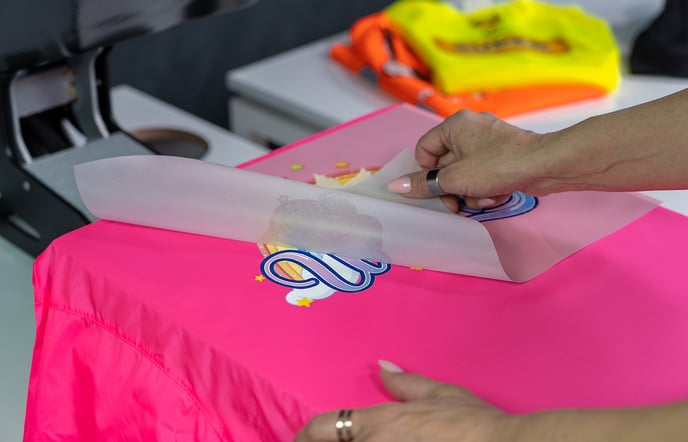Understanding DTF Printing: Tips and Tricks for Achieving Vibrant and Resilient Prints
Worldwide of textile printing, achieving lively and durable prints is a sought after skill that can boost the high quality of your result. Mastering DTF (Direct to Movie) printing needs a mix of technical understanding, accuracy, and focus to information. From choosing the best products to make improvements print setups and perfecting post-printing finishing strategies, there are various variables that can affect the end result of your prints. Recognizing how to browse these intricacies can make all the distinction in between a mediocre outcome and an absolutely phenomenal one.

DTF Printing Fundamentals
For those brand-new to the globe of fabric printing, understanding the fundamentals of DTF printing is important to mastering this innovative strategy. Straight to Film (DTF) printing is a modern approach that includes transferring designs from an unique film onto various fabrics using a warmth press. Unlike standard approaches like display printing, DTF offers advantages such as vibrant shades, elaborate describing, and the capacity to publish on varied products like cotton, polyester, and blends.
The process begins by publishing the style on an unique DTF film making use of a compatible printer with CMYK or CMYKW ink collections. As soon as the design is published, it is after that healed with a heat press to develop a resilient and sturdy print. DTF printing is known for its capacity to recreate intricate designs with high precision and shade accuracy, making it a popular choice for companies wanting to create customized garments, promotional things, and more.
Picking the Right Products

Just as crucial is the selection of the adhesive powder. The adhesive powder works as a bonding representative in between the printed layout and the textile, so it must have solid attachment residential properties to ensure a sturdy and lasting transfer. Different textiles might need different kinds of glue powders, so it is vital to match the powder to the textile kind for optimum outcomes - DTF Printing. By meticulously choosing the best materials for DTF printing, printers can boost the top quality, vibrancy, and durability of their prints.
Maximizing Publish Setups
When intending to attain the finest outcomes in DTF printing, meticulous attention to optimizing print setups is vital for ensuring top notch and exact transfers onto textiles. One key element to think about when maximizing print settings is the resolution.
An additional essential setup to maximize is the print speed. Locating the right balance between speed and top quality is vital. While increasing the rate can boost efficiency, it might endanger the last print's clarity and color saturation. Explore various speeds and observing the outcomes can help figure out the optimum setup for each print work - DTF Printing.
In addition, adjust shade profiles and making certain correct shade administration are crucial for attaining accurate and consistent colors throughout different prints. By adjusting color settings and profiles, printers can minimize shade deviations and generate consistent results, enhancing the total print top quality and customer complete satisfaction.
Preparing Artwork for DTF Printing
To guarantee ideal results in DTF printing, precise attention to information is vital when preparing art work for transfer onto fabrics. Begin by picking high-resolution photos to maintain clarity and sharpness in the last print. Vector graphics are preferred as they can be conveniently scaled without losing high quality. Transform the artwork to CMYK color mode to make sure that the shades equate properly from display to print. Readjust the shade degrees and comparison as needed to boost the vibrancy of the layout. When including text to the art work, select typefaces that are ideal and clear for the desired size. Remember to mirror the final style prior to publishing to make certain that it transfers appropriately onto the garment. Additionally, consider the material kind and shade when choosing the artwork, as these factors can impact the final appearance. By following these actions and paying attention to the try here details, you can prepare art work that is optimized for long lasting and dynamic DTF prints.
Post-Printing Finishing Techniques
Applying reliable post-printing ending up techniques is vital to enhancing the durability and visual allure of DTF prints on textiles. When the printing process is total, applying warmth to the published style is crucial.
As soon as the movie is eliminated, the print might need extra Your Domain Name healing time to better set the ink right into the fabric. This action aids improve the washability and durability of the print, guaranteeing it can endure numerous wash cycles without fading or fracturing.
Furthermore, cutting any excess film around the style can provide the final print a expert and tidy look. Making the effort to appropriately complete DTF prints post-printing can significantly affect the total quality and durability of the fabric design.

Conclusion
Finally, mastering DTF printing calls for a complete understanding of the fundamentals, picking proper products, maximizing print settings, preparing art work successfully, and utilizing post-printing finishing methods. By adhering to these pointers and techniques, one can achieve long lasting and vivid prints that satisfy their desired high quality standards. Consistent method and focus to detail are crucial in attaining effective outcomes in DTF printing.
From selecting the best materials to make improvements print setups and refining post-printing ending up strategies, there are numerous variables that can affect the end result of your prints. Unlike typical approaches like screen printing, DTF uses benefits such as lively shades, complex describing, and the capacity to publish on diverse materials like cotton, polyester, and blends.
As soon as the design is printed, it is then cured with a heat press to produce a lasting and durable print.When intending to achieve the finest outcomes in DTF printing, careful focus to optimizing print settings is important for making sure high-quality and accurate check transfers onto fabrics.In verdict, mastering DTF printing calls for a detailed understanding of the basics, choosing proper materials, optimizing print settings, preparing artwork efficiently, and using post-printing ending up techniques.